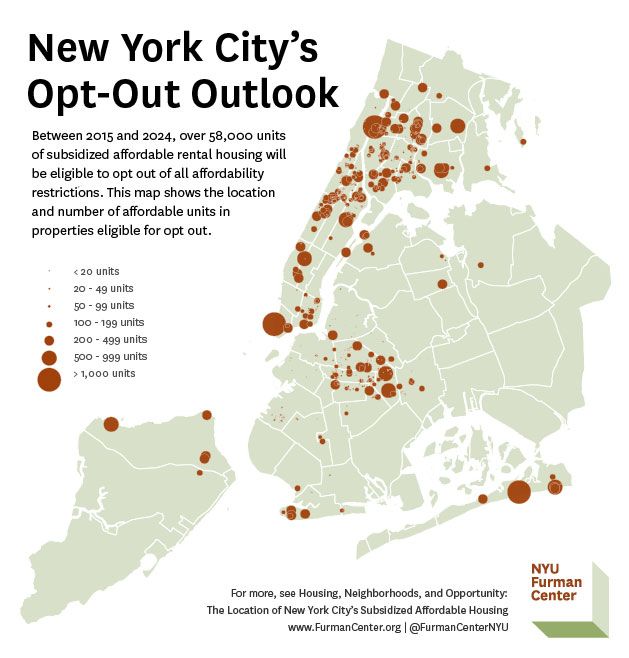
Report: High-Opportunity Neighborhoods in NYC are Losing Affordable Housing

Many property owners in New York City’s higher-opportunity neighborhoods are converting their subsidized properties to market-rate when their affordability restrictions expire. As a result, the city is losing affordable housing in the neighborhoods with the highest quality schools, lowest crime rates, and greatest access to jobs.
Housing, Neighborhoods, and Opportunity: The Location of New York City’s Subsidized Affordable Housing (PDF), a report released today by the NYU Furman Center’s Moelis Institute for Affordable Housing Policy, examines changes in the location and neighborhood characteristics of subsidized rental housing in New York City. The study shows that the distribution of subsidized rental units across New York City’s neighborhoods changed significantly between 2002 and 2011, not just as a result of new development, but also because of differential opt-out rates across neighborhoods.
Properties that opted out of all affordability restrictions between 2002 and 2011 were located in higher-amenity—and higher cost—neighborhoods than properties that were preserved during that time.
On average, the neighborhoods that lost affordable units commanded asking rents about $400 more per month than rents in neighborhoods where affordable housing was preserved. And compared to the typical neighborhoods where affordable units were preserved, neighborhoods with units that converted to market rate had better performing public schools, lower poverty rates, lower violent crime rates, and better access to transit and jobs.
Still, while subsidized rental housing tends to be in neighborhoods with higher poverty rates and lower-quality amenities, these neighborhoods do offer some compensating features in terms of access to services. The average subsidized rental housing in New York City is located closer to transit, parks, senior centers, and child care centers than the average housing unit in the city.
Over the next decade, over 58,000 units of subsidized rental housing will be eligible to opt out of affordability restrictions. Many of these are concentrated in high-cost neighborhoods close to the core business areas of Manhattan.
The report (PDF) also found that, between 2002 and 2011, the city’s new affordable units were constructed in neighborhoods that on average had a poverty rate over 30 percent, a violent crime rate in the top fifth of neighborhoods, and a local public elementary school where just 40 percent of students performed at grade level in English Language Arts.
Since 2000, just six percent of new subsidized affordable rental units have been located in Manhattan below 96th street, compared to 17 percent of subsidized rental units built in the 1970s.
_______
Read the report, Housing, Neighborhoods, and Opportunity: The Location of New York City’s Subsidized Affordable Housing (PDF).
View the press release (PDF) or the NYU Furman Center data visualization, New York City's Opt-Outs Outlook.
The Subsidized Housing Information Project (SHIP) Database is the NYU Furman Center's searchable database of privately-owned, subsidized rental housing in New York City, which combines data from nearly 50 datasets. The database collects and maintains detailed financial and physical information about the 2,500 properties, containing 235,000 rental units, ever financed in New York City.




